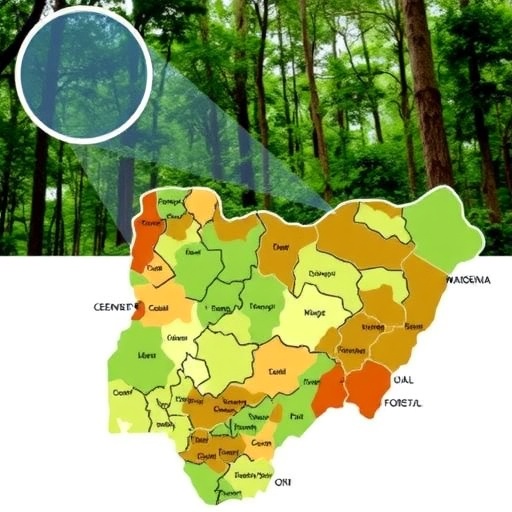In the heart of Southwestern Nigeria, the humid tropical rainforests present a vibrant canvas of biodiversity, ripe for exploration and study. Recent research has drawn attention to the contrasting ecological characteristics found in undisturbed forest reserves compared to protected forests in this rich biome. The study, conducted by Dada, Olusola, and Awotoye, provides critical insights into species diversity and structural traits affecting forest ecosystems. This comparative assessment could have far-reaching implications for conservation strategies and sustainable management practices in these vital habitats.
The primary objective of the study was to unravel the complexities of forest ecology by comparing undisturbed ecosystems with those subjected to varying levels of human activities and conservation efforts. Researchers meticulously gathered data regarding plant species diversity, density, and management practices which differ significantly between forest reserves and protected areas. The choice of sites was crucial, as it ensured that the comparison was grounded in robust ecological contexts, allowing for meaningful conclusions to be drawn about the effects of human interaction with these forests.
One of the remarkable findings of the research highlighted significant differences in species diversity between the two forest types. The undisturbed forest reserve exhibited a higher abundance of tree species, suggesting a more resilient and stable ecosystem. This is indicative of a more complex network of interactions among flora and fauna that typically thrives in unspoiled environments. In contrast, the protected forest showed signs of stress and reduced biodiversity, which may be attributed to disturbances from selective logging, agricultural encroachment, and other anthropogenic factors.
Structural characteristics also emerged as pivotal to understanding the ecological dynamics at play. The undisturbed forest reserves not only boasted a greater number of species but also displayed varied structural attributes such as tree height and canopy density. These structural elements play a crucial role in providing habitats and resources for a myriad of organisms, thereby influencing the overall health of the ecosystem. The intricate interplay between species diversity and structural complexity underscores the need for nuanced approaches in forest management and conservation.
The research underscored the importance of preserving undisturbed habitats, offering empirical support to the theoretical frameworks that advocate for biodiversity conservation. As ecosystems face unprecedented challenges due to climate change and increasing human encroachment, findings from studies like this one provide essential data that can help shape conservation policies and priorities. By prioritizing the preservation of undisturbed areas, conservationists can maintain the ecological integrity necessary for sustaining biodiversity.
Furthermore, while the protected forests serve as a crucial buffer against degradation, they require enhanced management strategies to bolster their ecological roles. The study highlights the need for more effective conservation measures that focus not only on protection but also on restoration and enhancement of structural characteristics that promote biodiversity. This could involve reforestation efforts, invasive species management, and community engagement in sustainable forestry practices.
The methodological rigor applied in this research is noteworthy. The researchers employed robust statistical tools to analyze and interpret their data, ensuring reliable and valid conclusions. This level of academic diligence not only enriches the study but also sets a benchmark for future ecological research in similar contexts. Standardizing methodologies can enhance comparability across studies, thus contributing to a broader understanding of the factors influencing forest ecosystems globally.
One of the striking revelations from this study pertains to the role of human activities in shaping forest dynamics. The ongoing developments in agriculture, logging, and urbanization pose significant threats to the structural characteristics of forests. While protected areas may provide respite from immediate threats, they are not impervious to the long-term effects of such activities. Thus, initiatives aimed at educating local communities about the benefits of forest conservation are becoming increasingly crucial in fostering stewardship and mitigating destructive practices.
Moreover, the findings have implications for the economic aspects of conservation. Sustainable forestry not only enhances biodiversity but can also provide livelihoods for local communities. By promoting ecotourism and sustainable harvest practices, there is potential for creating economic incentives aligned with conservation goals. This multifaceted approach can lead to healthier forests while simultaneously supporting local economies, illustrating that ecological and economic needs can coexist harmoniously.
As the world grapples with biodiversity loss, the insights gained from the assessment of forest reserves in Nigeria are potent reminders of the delicate balance that exists between humans and nature. The research encourages a paradigm shift toward valuing ecological health not just as a resource to be exploited but as a foundation for life on Earth. Each species lost represents not only a loss of potential ecological services but also a step away from the biodiversity that has supported human existence for millennia.
In conclusion, this comparative assessment carried out in Southwestern Nigeria contributes significantly to our understanding of forest dynamics, species diversity, and conservation strategies. The urgent need for protective measures driven by empirical studies is resounding. Ultimately, fostering environments that encourage biodiversity will not only benefit ecosystems but also humanity, uniting us in the shared responsibility of safeguarding our planet’s unique ecological heritage for future generations.
The study serves as a clarion call for researchers, policymakers, and the public to recognize the intrinsic value of undisturbed forests and to commit to actions that preserve their integrity and richness. Only through collective awareness and responsible actions can the delicate balance of these ecosystems be maintained, ensuring that they continue to thrive and sustain life.
Subject of Research: Species diversity and structural characteristics in humid tropical rainforests of Southwestern Nigeria.
Article Title: A comparative assessment of species diversity and structural characteristics in undisturbed forest reserve and protected forest in the humid tropical rainforests of Southwestern Nigeria.
Article References:
Dada, A.D., Olusola, A.J., Awotoye, O.O. et al. A comparative assessment of species diversity and structural characteristics in undisturbed forest reserve and protected forest in the humid tropical rainforests of Southwestern Nigeria. Discov. For. 1, 41 (2025). https://doi.org/10.1007/s44415-025-00035-y
Image Credits: AI Generated
DOI:
Keywords: Biodiversity, Forest Conservation, Tropical Rainforests, Species Diversity, Structural Characteristics.




